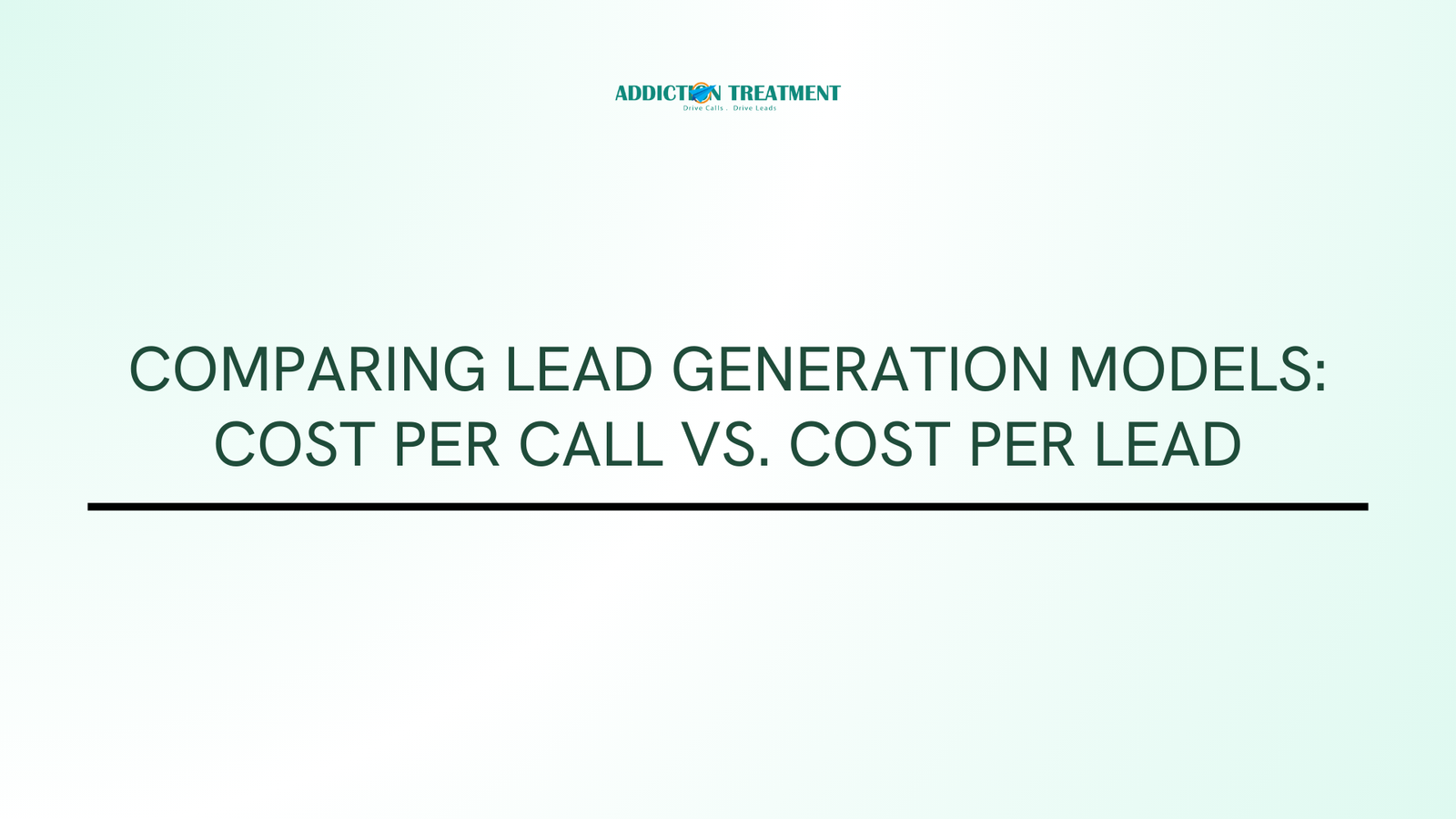Lead generation is the backbone of marketing efforts for businesses across industries, including addiction treatment centers, insurance providers, and legal services. Two popular models for generating leads are Cost Per Call (CPC) and Cost Per Lead (CPL). Each model offers unique benefits and challenges, and understanding their differences is essential for making informed decisions that align with your business goals.
This article compares the Cost Per Call and Cost Per Lead models, highlighting their strengths, weaknesses, and ideal use cases, to help you choose the right strategy for your lead generation campaigns.
What Is the Cost Per Call (CPC) Model?
The Cost Per Call model involves paying for qualified inbound phone calls. These calls are typically generated through marketing channels like search ads, display ads, or social media campaigns. Payment is only made when a call meets predefined criteria, such as duration or caller intent.
Key Features of CPC:
- Focuses on generating live, high-intent calls.
- Payment is contingent on specific call criteria (e.g., length of the call).
- Often used in industries where phone interactions are critical for conversions.
What Is the Cost Per Lead (CPL) Model?
The Cost Per Lead model involves paying for contact information (e.g., name, email, phone number) submitted by potential customers through forms or surveys. These leads are then nurtured through follow-ups, email campaigns, or other engagement strategies.
Key Features of CPL:
- Focuses on collecting customer information for future outreach.
- Payment is made per lead, regardless of their quality or conversion likelihood.
- Commonly used in industries where longer sales cycles or detailed follow-ups are required.
Advantages of the Cost Per Call Model
1. High-Intent Leads
Calls are typically initiated by individuals who are actively seeking help or services, resulting in higher conversion rates.
2. Immediate Interaction
CPC connects businesses directly with prospects, allowing for real-time engagement and quicker decision-making.
3. Quality Over Quantity
Since calls are pre-qualified based on criteria like duration or intent, businesses spend less time filtering unqualified leads.
4. Trackable ROI
Tools like call tracking software provide detailed insights into call performance, helping you measure ROI accurately.
Challenges of the Cost Per Call Model
1. Higher Costs
CPC campaigns often have higher upfront costs compared to CPL, as calls are considered high-value leads.
2. Limited Scalability
Generating high-quality calls can be challenging, especially in niche industries or markets with limited demand.
3. Call Volume Dependence
Success depends on ensuring your team is available to handle inbound calls promptly, as missed calls equal missed opportunities.
Advantages of the Cost Per Lead Model
1. Scalability
CPL campaigns can generate a large volume of leads, providing businesses with a broad pool to nurture.
2. Lower Initial Costs
Paying per lead is typically more affordable upfront compared to paying per call, making it attractive for businesses with smaller budgets.
3. Flexibility
CPL works well for businesses with longer sales cycles, where nurturing leads through email or calls over time is essential.
4. Diverse Channels
CPL campaigns can utilize multiple lead generation channels, such as email opt-ins, content downloads, or survey submissions.
Challenges of the Cost Per Lead Model
1. Lower Lead Quality
Since payment is made for every lead, the pool often includes unqualified or low-intent prospects.
2. Time-Intensive Nurturing
Converting CPL leads into customers requires significant effort in follow-ups, email campaigns, and other engagement tactics.
3. Potential for Fraud
Some CPL campaigns may attract fake or duplicate submissions, inflating costs without delivering value.
4. Delayed Conversions
Unlike CPC, where calls can lead to immediate conversions, CPL leads may take weeks or months to close.
Cost Per Call vs. Cost Per Lead: Key Differences
| Feature | Cost Per Call (CPC) | Cost Per Lead (CPL) |
| Focus | Real-time, high-intent phone calls | Capturing contact information for follow-up |
| Lead Quality | High | Varies |
| Conversion Speed | Immediate or faster | Delayed, depending on nurturing process |
| Cost | Higher per call | Lower per lead |
| Ideal Use Case | Industries requiring immediate interaction (e.g., healthcare) | Industries with longer sales cycles (e.g., B2B services) |
| Scalability | Limited | High |
Choosing the Right Model for Your Business
When to Choose Cost Per Call (CPC):
- You Need Immediate Conversions: If your business thrives on real-time interactions, such as booking appointments or closing sales over the phone, CPC is ideal.
- Your Audience Is High-Intent: CPC works best for industries like addiction treatment, insurance, or legal services, where callers are often ready to make decisions.
- Your Team Can Handle Calls: Ensure your team is available to manage call volumes promptly and effectively.
When to Choose Cost Per Lead (CPL):
- You Have a Longer Sales Cycle: For businesses where customers require more time and nurturing before converting, CPL offers a cost-effective solution.
- Your Budget Is Limited: CPL allows businesses to generate a higher volume of leads at a lower cost, suitable for startups or businesses with tight budgets.
You Have a Strong Nurturing Process: If you excel at lead nurturing through email campaigns, follow-ups, or content marketing, CPL can be highly effective.
Combining CPC and CPL for Maximum Results
Many businesses find success by integrating both models into their lead generation strategy:
- Use CPL for Awareness: Start by generating a broad pool of leads through cost-effective CPL campaigns.
- Implement CPC for High-Intent Leads: Run targeted CPC campaigns to capture prospects who are ready to engage immediately.
Nurture and Retarget: Use CPL data to retarget prospects with CPC campaigns when they show readiness to convert.
Measuring Success in Both Models
To determine the effectiveness of your chosen lead generation model, track these metrics:
- Cost Per Acquisition (CPA): Compare how much you spend to acquire a customer in each model.
- Lead-to-Customer Conversion Rate: Evaluate the percentage of leads that turn into paying customers.
- ROI: Measure the return on investment for both CPC and CPL campaigns to identify the most profitable strategy.
- Call Duration and Quality (CPC): For CPC, analyze call duration and engagement levels to assess lead quality.
Lead Engagement (CPL): Track open rates, click-through rates, and responses for CPL leads.
Conclusion
Both the Cost Per Call and Cost Per Lead models offer unique advantages and challenges, making them suitable for different business needs and goals. CPC is ideal for businesses that require immediate engagement with high-intent prospects, while CPL works well for those focused on nurturing a large pool of leads over time. By understanding the strengths of each model and combining them when necessary, you can create a well-rounded lead generation strategy that maximizes ROI and drives meaningful results.


Leave a Reply